Have you heard of or seen people babywearing? Babywearing is when you “wear” your baby on your chest or your back, held on and secured with a wrap. This way of carrying a baby has been around for many, many years and has many benefits.
In this blog, you will discover the joys of babywearing and learn more about those benefits. You’ll also find essential tips for safe and comfortable baby carrying.

Meet and connect with other families in support groups available through The Mother Baby Center.
What is babywearing?
Babywearing is when you wrap a newborn or baby and carry them on your body, whether in the front or the back. You do this with a babywearing wrap or a sling. Babywearing is a safe practice, but it does need to be done correctly.
This type of carrying is popular because you have more mobility and freedom. Instead of holding your baby in one or both of your arms, you can carry your baby on your chest and use your arms and hands like normal.
Eight benefits of babywearing
There are many benefits of babywearing for both the child and the parent or caregiver. Newborn baby wearing encourages breastfeeding, reduces crying, adds convenience for the caregivers, and so much more.
Encourages breastfeeding
One incredible benefit of babywearing is that it encourages breastfeeding. It’s incredibly convenient to breastfeed a newborn in a baby carrier because it’s acts as a breastfeeding sling.
In fact, a study on the use of a baby chest carrier and its effects on breastfeeding found that “…the use of baby carriers in healthy term infants during their first month is associated with increased breastfeeding duration.”
For breastfeeding, you can roll down your babywearing sling and feed your newborn. Breastfeeding is more convenient, and possibly more natural for the caregiver which generally makes it a little easier. You can also consult with a breastfeeding and lactation specialist for additional support to successfully breastfeed while babywearing.
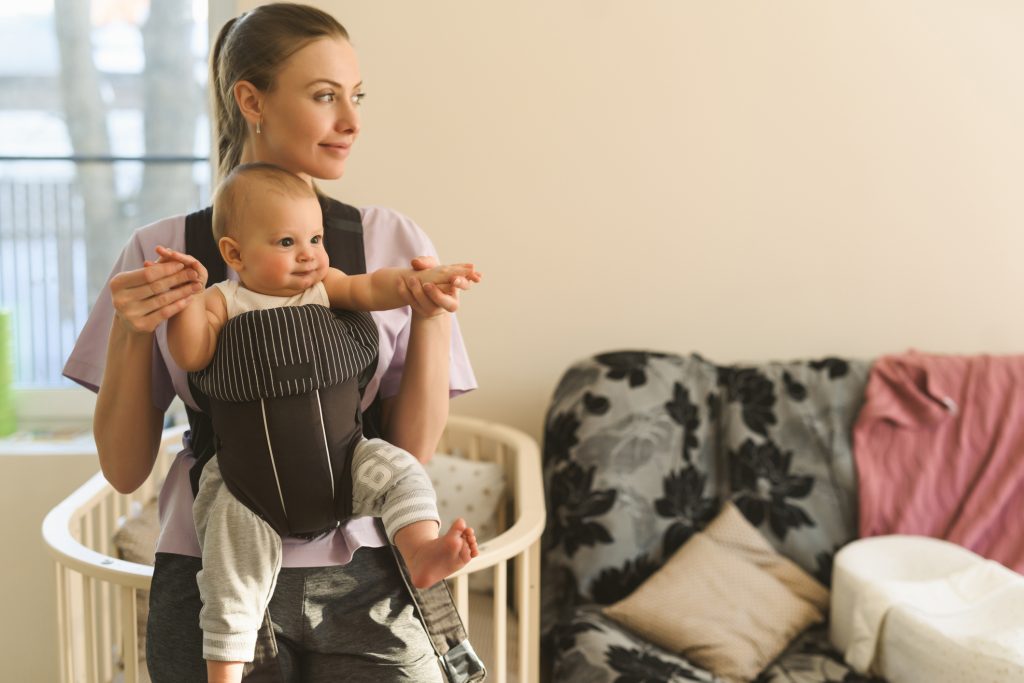
Explore these nine breastfeeding positions in addition to babywearing to support you and your baby.
Improves bonding with baby
Like skin-to-skin contact or kangaroo care, babywearing can improve your bond with your baby. When your babies are held close to you, it promotes attachment and bonding between the baby and the carrier.
Plus, when you snuggle your baby, a hormone called oxytocin, also known as the love hormone, is released. This hormone builds that incredible bond between you and your baby.
Reduces reflux
Having a baby who has reflux can be really hard. It’s difficult as a caregiver to watch, but it’s also exhausting. Between all the baths and outfit changes, it’s especially difficult not knowing what to do.
Fortunately, one thing you can do is babywear. Holding your baby upright in the baby carrier after eating can help them with their reflux. It can ease their pain and discomfort as they digest by being positioned in this upright position.
Helps with tummy time
Babywearing carrier fun fact: When your newborn is in their carrying wrap, it can often count as tummy time! Being in this position can help babies learn to hold their heads up, utilize their stomach and back muscles, and strengthen their neck muscles. While it can do all of these things just like tummy time can do, babies can also fully relax and even fall asleep while in babywearing carriers.
Supports physical growth
Wearing your baby can actually support their physical growth as well. Similar to the point above, babywearing helps the baby develop muscles and strength. The physical contact between baby and caregiver with the release of oxytocin can stimulate physical growth, helping the baby grow big and strong.
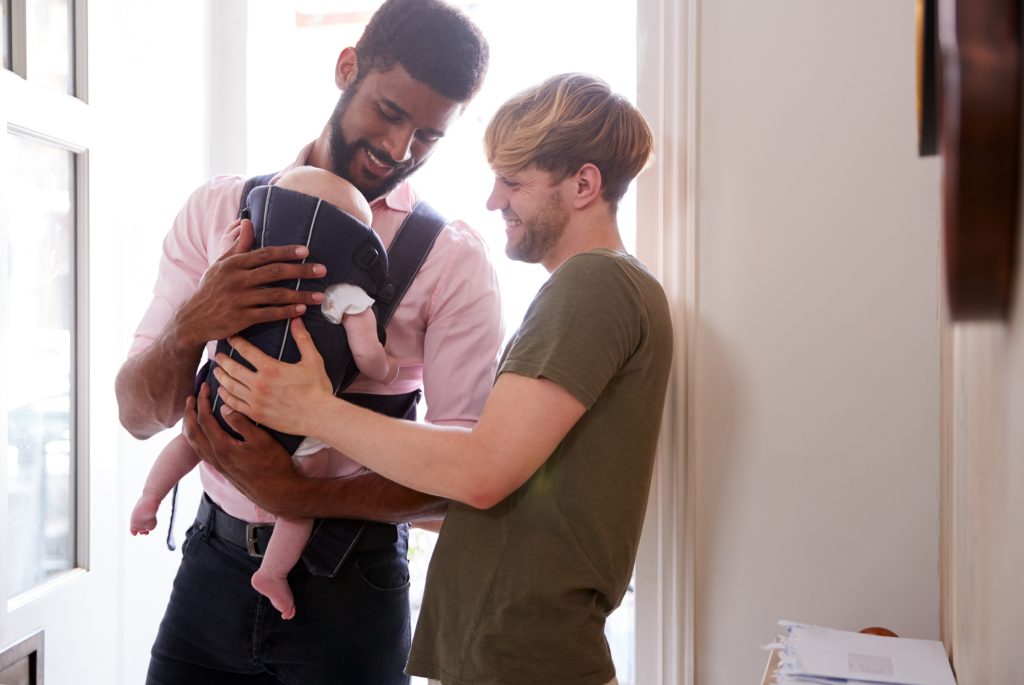
Discover more articles offering guidance for your growing family from The Mother Baby Center blog.
Encourages sociability and language development
When a babywearing, your child is held higher than in a bassinet or stroller. Having the height advantage, they can see their caregiver’s interactions, and hear voices and conversations. This encourages their own sociability and language development.
Reduces crying
Helping your baby when crying is one of the main goals (and struggles) during parenthood. While a newborn in a baby carrier might not stop crying completely, it’s a great option to try. In fact, in a study, babywearing reduced crying in infants up to 43% during the day and 51% less in the evening.
Supports neurological development
The more a baby experiences, the more they learn. Similar to how babywearing can encourage sociability, it also encourages neurological development. While being worn, there is no shortage of movement to observe. All of these stimuli can help develop their brains and help them learn new things.
Convenience for caregiver
Once you see a babywear wrap and how it works, you’ll see just how convenient it can be. Babywearers love being able to have their arms and hands free can make life a little easier. While there are many benefits of babywearing for your baby, this benefit helps you out too.
However, with your hands free, you still need to be alert and aware of what activities you choose to do. You have to make sure you aren’t doing anything that might harm your baby who juts out a little farther than you.
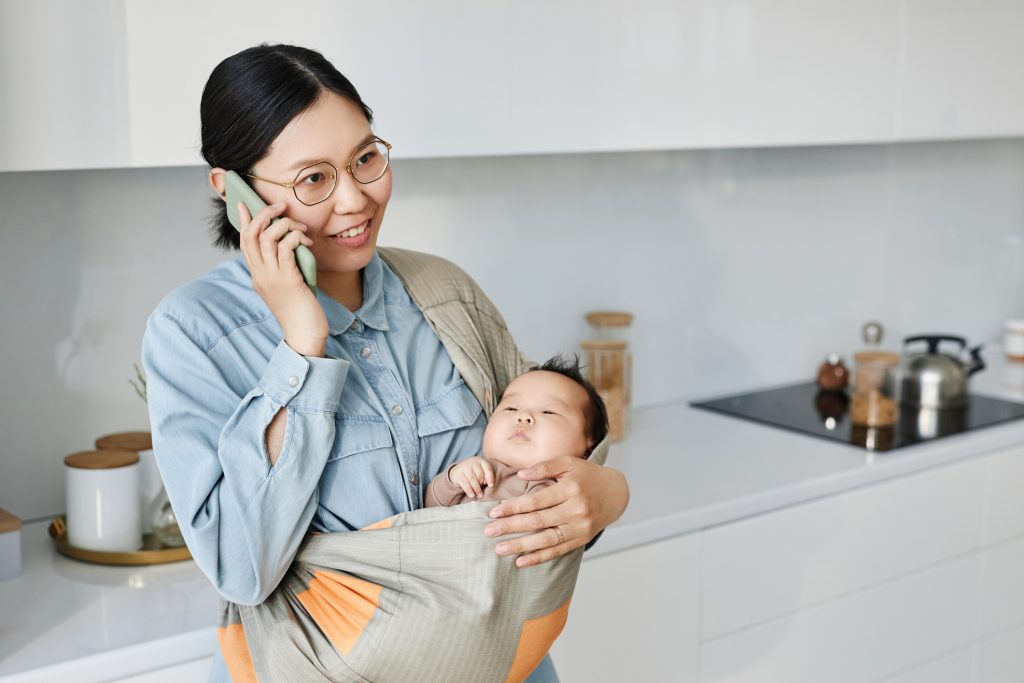
Follow The Mother Baby Center on Facebook for the latest news and tips.
T.I.C.K.S. rule for safe babywearing
While babywearing has many benefits for caregivers and babies, you must always prioritize safety first.
There is a perfect way to remember safety while babywearing; an acronym created by the UK Slick Consortium known as the T.I.C.K.S. rule. It’s an easy way to remember how to keep your baby safe and comfortable while babywearing.
Tight carrier, not loose fitting
Your babywearing wrap or sling should be tight or snug to you. It should not be loose fitting as that can allow your baby to slump and cause difficulty breathing. Plus, loose-fitting fabric or carrier can cause additional stress and strain on your back, or get caught on things nearby.
In view at all times
When you baby wrap your newborn, you should be able to see your baby’s face when you glance down. You should not have to move any part of your carrier or sling to see their face. This ensures that your baby can breathe and nothing obstructs their breathing, whether that’s extra fabric from the sling or part of your clothing.
Close enough to kiss
Some people may feel confused about how high or low to wear their baby at first. One way to figure this out is to simply lean your head down. If you can give the top of your baby’s head, or their forehead, a kiss you are all set. But, if you have to lean even further down to reach them, you need to move the waistband of your carrier up on your body.
Keep chin off chest
People often worry if their baby can breathe while in a sling. The rule here is to make sure they have room between their chin and chest so their nose and mouth are clear and their airway is not constricted. A rule of thumb is to make sure you can fit two fingers between their chin and chest while in the carrier.
Supported back
Finally, you want to make sure your baby’s back is supported while being carried. When supported, they will not be able to slump or move around much which keeps their back in its natural position.
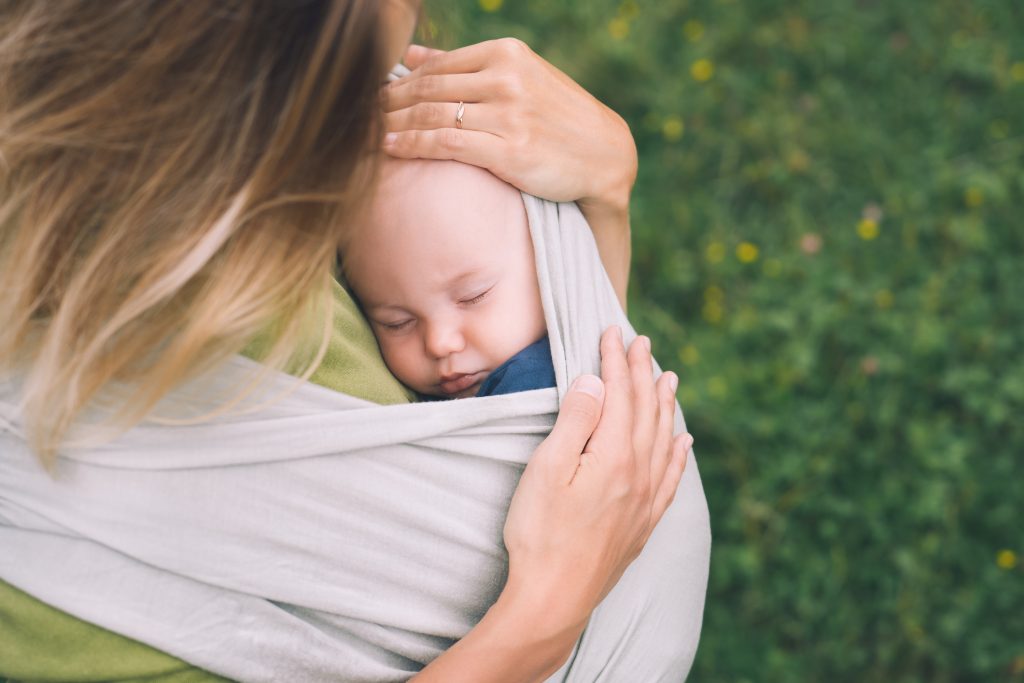
Learn more about the 4th trimester and how to support your baby’s development and growth.
Additional safety tips
While the T.I.C.K.S. rule is great for babywearing and getting comfortable with general positioning. However, there are additional safety tips to be aware of.
- Monitor baby temperature: Because you are wearing your baby pretty close to you, monitor their temperature, especially in warm rooms or climates. Do this by feeling the back of their neck to see if it’s warm, if their cheeks are red, or if they are short of breath. They are likely to get much warmer more quickly being so close to you for extended amounts of time.
- Baby hips in “m” or squat position: The “M” position or the squat position, is where baby’s legs surround the carrier’s hips. This position can support healthy hip development.
- Check for carrier wear and tear: Like many other items we use daily (or often), we should always check for wear and tear to make sure it’s still working properly and safely. Baby carriers are no different; check them and replace them once it shows signs of aging or wear.
- Follow your baby’s cues: This safety tip may seem obvious, but sometimes reminders are good! If your baby seems uncomfortable or your baby feels too hot in the carrier, follow their cue. Take them out and try something else.
- Practice: Practice makes perfect! Practice wearing your baby for short periods at first to get you and your baby comfortable and used to this new activity. Then, as long as it goes well, you can try wearing them for longer.
- Mindful of general safety: The general rule of babywearing is: If you wouldn’t do it holding your baby, don’t do it while you babywear. While babywearing may feel like it gives you the freedom to do many things, you still shouldn’t do it if it’s unsafe.
Different types of carriers for babywearing
There are a lot of different types of carriers for babywearing. Below, are the seven main types of babywearing carriers: Soft-structured carriers, stretchy wraps, Mei Tais woven wraps, slings, ring slings, and pouch slings.
Finding which type of carrier works best for you will depend on a few factors. Consider the age of your baby and the activities you want to do while carrying them. Each type of carrier has pros and cons that will influence your decision.
No matter which carrier you choose, please follow the instructions for each.
Soft structured carriers (SSCs)
Soft structured carriers, often called SSCs, are worn similarly to a backpack with padded straps around the shoulders. You can wear these carriers on your chest or your back. People like this option for a carrier as it’s pretty easy to use and doesn’t involve much wrapping.
These carriers are typically worn after your newborn has grown a little more into the baby stage, but it depends on the brand. SSCs can be used into toddlerhood too which makes them a long-lasting option!
Stretchy wraps
Stretchy wraps are ideal for babies under one year old. These wraps are great for many things especially if you live in harsh climates or have limited storage. There are stretchy carriers made for colder temperatures, and ones for warmer temperatures that keep the baby (and you) cool. Plus, they fold up compactly and can be easily stored.
While these may look complicated, once you know what to do they are very easy to use! These wraps you put on, and then place your baby in the carrier making it easy to go out and about with your routine.
Mei Tais
Mei Tais are great for newborns up to toddlers. The Mei Tais wraps are similar to soft structured carries because you can wear your baby on your chest or back. They are similar to woven wraps because of the way you use them – they have long straps you wrap around your baby but also still have the structure of a SSC which people tend to like.
Woven wraps
Like stretchy wraps, woven wraps resemble the womb in how they hold newborns and babies making this wrap a popular option.
Woven wraps may look similar to stretchy wraps as they are long pieces of fabric, but the difference is in the material. The material of woven wraps is more supportive because it has less stretch making it stronger and more firm. In fact, these carriers are long-lasting and can be used into toddlerhood.
However, some people have a harder time getting used to how they work. This option has a bit more of a learning curve and will take some extra practice, and patience.
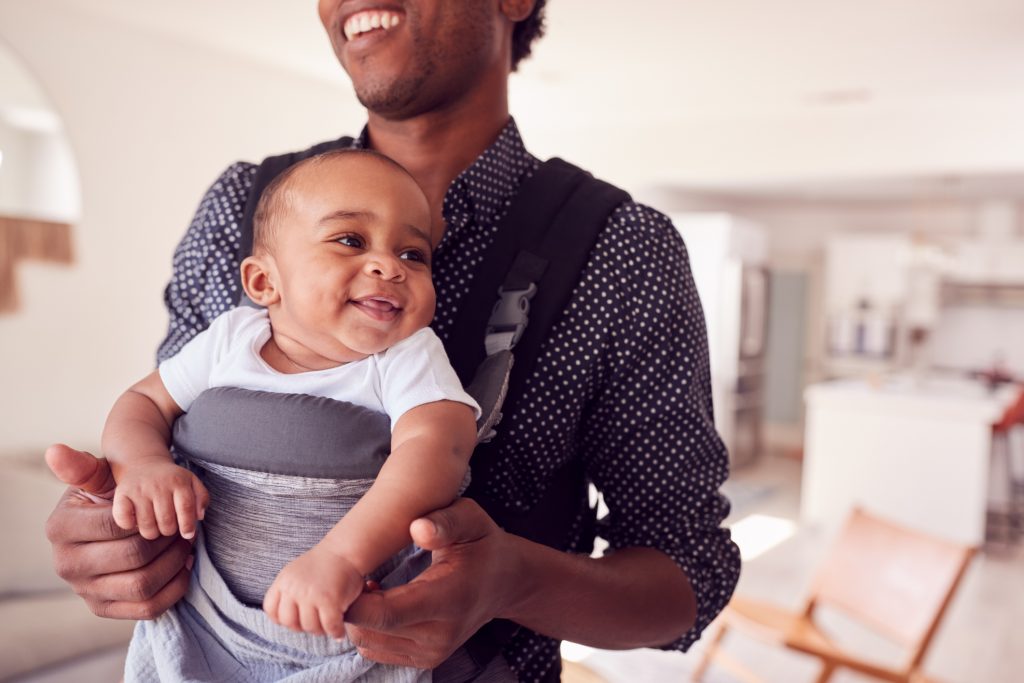
Ensure your child’s health with a caring, and experienced physician, and find a provider today.
Slings
Sling baby carriers are different than the options above because these are wrapped around just one shoulder rather than two. They are typically made with thinner fabric making them breathable for both you and baby.
Ring sling
Ring slings and pouch slings are a specific type of sling. You wrap a long piece of fabric around one shoulder, and then the ends of the fabric come together with two rings, which is how this carrier got its name.
Many wear their newborn or baby facing them when using the ring sling. Because of this position, one major benefit of a ring sling is breastfeeding. Many people find this type of baby carrying to be the most convenient way to wear your baby and breastfeed.
Pouch sling
Unlike a ring sling, pouch slings are when the fabric does not have loose ends, and is one big loop creating a pouch for your baby to sit in. These slings are easy to pack in your diaper bag, and easy to use as there isn’t any wrapping or straps involved. Your baby will sort of recline in the pouch sling, making it extra important to check on their airways regularly.
How to choose your baby carrier
Like parenting, baby carriers aren’t something that is a one-size-fits-all. Make sure you think about the needs of why and how you want to use a carrier. You should look into multiple options and explore which may be best for you and your baby.
- Comfortability: Try out different carriers if possible and pick which one seems to be most comfortable for you – and your baby.
- Age: There may be age restrictions or recommendations for different types of carriers. Make sure to follow the instructions on your chosen carrier.
- Weight: Similar to age, different carriers may only allow a certain weight limit when using them. Make sure to look at this before purchasing to make sure your child fits those requirements.
- Activities: Some carriers work better for some activities than others. Like ring slings, people tend to favor these for breastfeeding over others.
Holistic care through pregnancy and postpartum from The Mother Baby Center
There are certainly many considerations for babywearing and finding the right fit for your needs. The numerous pros and cons of each type of carrier, the way to wear them, and how to choose which is best can be overwhelming. Successfully using a carrier always takes time and patience for everyone but it is worth the convenience and connection it can bring.
At The Mother Baby Center, we deliver expert care through every stage of pregnancy from newborn care to the postpartum period. We believe in holistic care because we know that each journey and family is unique and deserves time, care, and attention. To learn more about how The Mother Baby Center can support your family, find a provider or visit one of our locations.
Babywearing FAQs
When can you start babywearing?
People often wonder when you can start babywearing. If you gave birth to your baby, a huge component of this is when you start to feel fully healed after labor and delivery. Your body needs to be ready to be able to hold a baby before you start to carry one.
How long can you babywear?
You can babywear as long as you and your baby wish, as long as the carrier allows, meaning many of them have weight restrictions you should follow. Based on those restrictions and if your child still fits in the requirements, it’s totally up to you how long you want to babywear.
Can you babywear a newborn?
Yes, you can babywear a newborn. People have been babywearing newborns for thousands of years. As stated above, you do want to make sure your body is fully healed from birth before you decide to start babywearing. Also, make sure you look at the weight recommendations on your carrier before deciding to carry your newborn.
When should you stop babywearing?
You should stop babywearing when it becomes uncomfortable or a burden for you or your baby. This can be due to many factors like weight, stress on your back, convenience, etc. You will know when it’s time to stop babywearing if it becomes painful or uncomfortable.
Does babywearing count as tummy time?
When you babywear your newborn, it can often count as tummy time. When a baby is in a baby carrier, it can help them learn to hold their heads up, utilize their stomach and back muscles, and strengthen their neck muscles. These are all of the things tummy time does too!
How long can a baby be in a baby carrier?
There is no official timeline for how long a baby can be in a baby carrier. However, you want to make sure you and your baby are comfortable and happy. You will also want to check the carrier is secure and in the right position if you wear it for long periods.
When can you babywear?
When you can babywear will depend on the carrier. Some are made for and can fit newborns, and some will want you to wait until your baby grows to a certain weight. You will want to follow the instructions and guidelines on your chosen carrier to know when you can babywear.
Can you babywear twins?
This might sound like a lot, but yes! You can babywear twins. There are many different ways you can babywear with twins. You can get a carrier that has spots for both of them, you can have your partner carry one while you have the other baby, and more.